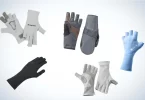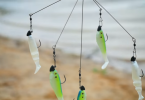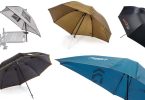Introduction to Spinning and Casting Rod
There are two most common types of fishing rods that are spinning rod vs casting rod. Many novice anglers get bewildered by the differences between casting and spinning poles when gearing up on the water.
They have disoriented which one is best for their specific fishing purpose. For some approaches casting rods are excellent, while in several angling tactics spinning rods perform superiorly. Many newbie anglers tend to start their fishing campaign with one type of fishing pole, and after passing some time, they realize the other kind of rod might provide them additional advantages.
A spinning rod is a specific fishing rod available in different sizes ranging from a light action to a medium one and a tenacious spinning rod. While a casting rod is a type of fishing rod in which when the fish pulls the lines of the casting rod, it is angled over the eyelets and grasps an upward position.
So this article will explore distinctions between ‘casting’ and ‘spinning’ fishing rods that will help you select suitable rod-based on your skills
What Is A Spinning Rod?
A spinning rod is a particular type of fishing pole designed to operate with a spinning reel. Its reel is detected pointing downwards on the rod handle. The reel guides are located under the rod pole because the reel handle rests on the bottom of the spinning rod. It fixes them in the same position as the reel.
The backbone or spine of a spinning rod runs along the top of the pole compared to line guides. The spinning rods are typically for casting and retrieving lures. But you can use them for almost any kind of fishing, such as bottom fishing, bobber fishing, live lining, trolling, boat fishing, ice fishing, and surf fishing.
What Is A Casting Rod?
A casting rod is a type of fishing pole prepared with a casting reel. This reel may be a baitcasting reel, level-wind reel, or a spin-cast reel. That’s why Casting rods are also mentioned as baitcasting rods. They also possess great angling accuracy and withstand heavier lures.
They are often designated with a letter “C” in the labels as in “HS94MC”. Casting rods are artistically composed to allow a sinker out slowly or trolling with a downrigger.
The casting rod is the complete opposite of a spinning rod. When you use a casting rod, the rod is bent over as the eyelets take an upward position when the fish pulls the lines of the casting rod. It has a reel handle that is detected disclosing upwards on top of the rod handle. And the backbone of the pole with the line guides is pointed, running along the top of the rod.
Difference Between Spinning Rod vs Casting Rod:
Orientation of Reel Seat:
As compared to casting rods, spinning rods are upside down. A spinning rod has a reel seat that is prepared to hold a spinning reel pointing downwards. A casting pole has a reel seat that can hold a baitcasting reel specifying upwards on the head of the reel handle.
Position of Line Guides In The Rods:
The line guides rush besides the bottom of the pole in the spinning rod. While the line guides of a casting pole dart along the top. But you will be noticed that in both types of rods, the line guides are on the same side of the pole as the reel seat.
Size of line guides:
A casting rod has the line guides relatively short in size with the whole length of the rod. Although, spinning poles close to the handle have the line guides much longer than those close to the tip. This design modifies the specious diameter of the line spool of a spinning reel.
The Number of Line Guides:
The spinning rods have a smaller number of line guides arranged distant from each other than those on casting rods.
Location of Rod Backbone Or Spine:
The backbone on a spinning pole runs along the side of the blank across from the line guides. While in the casting pole it is situated on the same side as the line guides.
The Number of Tapers:
As compared to casting rods, spinning rods have a higher taper from base to tip.
Reel Type:
A casting rod demands a baitcasting reel that has to resemble a small winch displayed on the rod. An underslung, open-faced spinning reel utilizing the spinning rods provides a revolving surety to wind the line.
Winning ability:
With the help of spinning reels, you can cast lighter lures and make longer casts. Baitcasting reels provide more accurate casting that can win out when it comes to power.
Advantages of Spinning Rods:
- They are highly versatile and allow you to use them for all kinds of fishing.
- It comes with a spinning reel that is quite a straightforward mechanism and makes its use simple and consistent.
- A spinning rod is likely to make fishing more manageable for a novice.
Advantages of Casting Rods :
- They offer a greater casting distance that enables you to reach more fish.
- Using heavier lures, you can catch bigger fish, like bass and trout.
- Accessible with a rotating spool with a high-quality line mechanism, they possess an excellent dragging system.
We Need Both Types:
When you pay attention to the strengths and weaknesses of a spinning rod vs casting rod. It becomes easier to evidence that a seasoned angler is going to need both categories of rods.
Let’s view a few situations when you can choose a piece of spinning equipment, and then inspect scenarios in which baitcasting gear would be the best tool for the task.
When To Choose Spinning Rod:
One of the principal benefits of spinning tackle is that it allows you to cast very light lures with it. The line of the rod can flow off the spool with zero resistance. It can dribble off freely in big loops. These rods are best for presenting surface baits of all kinds. This rod is the favorite choice of those anglers who love to use topwater lures.
You can cast light surface plugs and buzz baits using these spinning gear. It also allows you to throw lighter soft plastic rigs like those used in finesse fishing by the fisherman. Spinning gear is often preferred in bait fishing because its large spinning reel enables you to make fabulously long casts. And anglers can fish with lighter baits such as poppers and tiny worms.
When To Choose Casting Rod:
Baitcaster’s low-profile mounting and smooth operation makes it a favorite choice for all types of anglers when targeting bass in heavy cover with a jig or when crushing a big-lipped crankbait in fifteen feet of water deep in the lake. Anglers can achieve greater casting accuracy with the operation of a baitcasting reel.
Most models of casting rods provide considerable fine-tuning that can produce astonishingly accurate targeting. The rod’s direct, in-line power comes from the gear design’s spool orientation that keeps anglers in complete control. It creates forceful feelings when working a lure or pulling a lunker out of its lair.
Some popular baits commonly get paired with a baitcasting rig, such as spinnerbaits, Texas-rigged worms, swimbaits, and jerk baits. Any lure with a reasonable weight can be a good contestant for use with a baitcasting rig.








